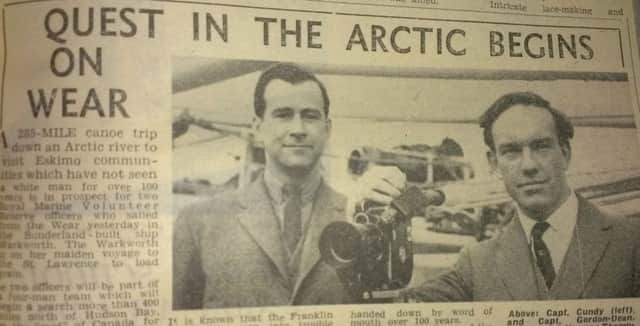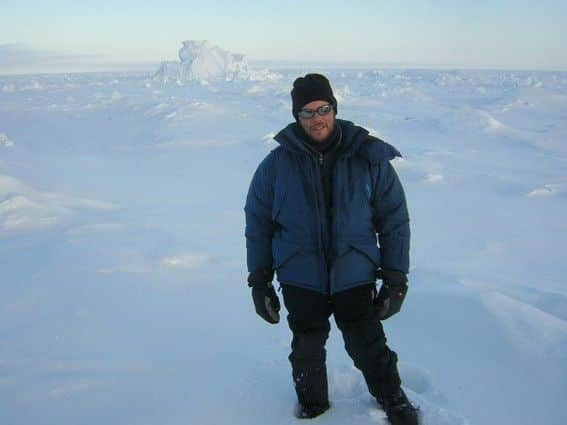We asked for answers to a Wearside memory lane poser - and got a reply from Providence, USA


Our thanks go to Russell A. Potter, the Professor of English and Media Studies at Rhode Island College,in Providence, USA.
He was fascinated by our recent focus on the Sunderland ship The Warkworth.


Advertisement
Hide AdAdvertisement
Hide AdLast week, we told how Captain Robert W.F. Cundy, a 31-year-old London journalist in 1962, sailed on the ship.
Cundy was eventually joined by a three-man team on a voyage which was eventually destined for St Lawrence in Canada.
Their mission was to search an area more than 400 miles north of the Hudson Bay. They were going to the roof of Canada to look for relics of Sir John Franklin’s ill-fated expedition of 1845.
The Echo first covered the story in 1962 when we told pf Cundy’s mission and how the Franklin expedition of 1845 ran into trouble near King William Island on the Canadian Arctic coast.


Advertisement
Hide AdAdvertisement
Hide AdThe 105-strong party decided to abandon their boats and travel down the Chantrey Inlet and up the Back River to a trading post which was several hundred miles inland.
Some evidence suggested the party pushed at least 100 miles down the inlet.
But Eskimo legends suggested others got further and the mystery deepened. That’s where the crew of the 1962 expedition came in.
They were hoping to solve many of the questions left by their counterparts 117 years earlier. And that’s where we took up the tale, asking if anyone could tell us what happened to Cundy’s 1962 attempt to follow Franklin’s journey.
Advertisement
Hide AdAdvertisement
Hide AdRussell - a “long time scholar” of the expedition - took up the story.
He said: “Cundy was apparently inspired by retired Rear-Admiral Noel Wright’s book Quest for Franklin (1959), which offered a number of theories about where one ought to look for traces of the lost Franklin expedition.
“Wright had noted, accurately enough, that the retreating Franklin survivors had declared, in their last and only note that they were heading for the Back River. Wright knew that the mouth of this river had been charted in the 1830’s by Dease and Simpson, two Hudson’s Bay surveyors, and that they had built cairns along their route.”
Cairns were the natural repository for messages. If a message was removed, it was custom to either return it or leave a copy along with a new message to record your own visit.
Advertisement
Hide AdAdvertisement
Hide Ad“Wright was especially confident about the Dease and Simpson cairn left at Cape Brittania at the mouth of the Back River,” said Russell.
“So Cundy and his men planned this cairn as their goal.”
The men canoed to their destination. Once there, said Russell, “they found only a ‘small yellow film can, wrapped in polythene.”
It had a short note in it which had been left two years earlier by a B.G. Craig who was carrying out a geological survey of Canada.
It simply said: “Probable site of Simpson’s Cairn. No Letters or Relics of Franklin Expedition found.”
Advertisement
Hide AdAdvertisement
Hide AdRussell added: “It must have been a very bitter disappointment to them to learn that the cairn had already been searched (perhaps B.G. Craig had also read Wright’s book -- it’s possible).
“Some years later Cundy wrote a well-received book about his trek, titled simply Beacon Six.
“As to myself, I’ve been researching and writing about the Franklin story for 20-odd years now. For the past six years, I’ve maintained a blog, Visions of the North, which has over 200 posts about various aspects of the Franklin mystery.”
Russell’s own new book, Finding Franklin: The Untold Story of a 165-Year Search, will be published in September by McGill-Queen’s University Press in Canada. It will be available in Europe and the USA.
Advertisement
Hide AdAdvertisement
Hide AdIn the meantime, our thanks go to Russell and our other readers who came up with the answers yet again.
It only leaves the question of what did happen to the original Franklin expedition of 1845. More of that soon.